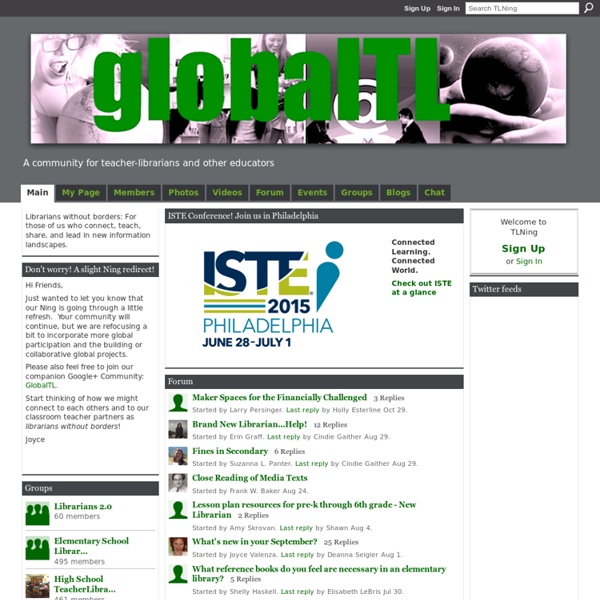



Classroom 2.0 iLearn Technology Classify -- an Experimental Classification Service Enter an ISBN, OCLC#, UPC, or ISSN Standard Number: An ISBN is a unique number assigned to an item by its publisher. Each ISBN is a 10 or 13 digit number. Thirteen-digit ISBNs must begin with either 978 or 979. Enter ISBNs with our without hyphens. For example; OCLC assigns a unique number to each bibliographic record input into WorldCat. The Universal Product Code (UPC) is a barcode symbol that is used to track trade items in stores (e.g., audio and video products). The first digit is the Number System Character (NSC) which appears on the left side of the symbol outside of the bars. Enter all digits found on the item (e.g., 008817006925). An ISSN is a standardized international code which allows the identification of a serial publication.
About the ILN | International Librarians Network The International Librarians Network (ILN) peer mentoring program is a facilitated program aimed at helping librarians develop international networks. We believe that innovation and inspiration can cross borders, and that spreading our networks beyond our home countries can make us better at what we do. Participants in the program are matched with others outside their country, based on the information they provide to the program coordinators. The International Librarians Network is run by volunteers all around the world. While the ILN enjoys the support of many esteemed professional and commercial bodies worldwide, it is run independently. More details on this program, including how to participate and how to get in touch with program and country coordinators, can be found on this website using the navigation above. Like this: Like Loading...
Free Technology for Teachers edWeb: A professional online community for educators Book Cover Images and Copyright - The Librarian Who Doesn't Say Shhh! I’m creating this post because I get a surprising number of hits on my FAQ page about this specific question! I figure people are googling the question, so crafting a post on it might be helpful for my googlers (this kids googling for book reports on The Time Machine, however, are still out of luck). The question comes from librarians and teachers, and involves some combination of: How can you use copyrighted book cover images on your blog? And this is actually a really fascinating question! I was right. First, I must say that most of the books I read and review now are books I receive for review, and publishing the review with a cover image is encouraged by the publishers. Second, most cover images I use come from sites like Goodreads and Library Thing. Using a cover image in a blog post might be considered a reasonable risk. Of course, this only applies to cover images! If you worry about posting an image, there are two options that might be worth considering: Tara Like this:
Project Wombat Learning In Burlington tsū In Twitter, An Emerging Creative Medium For The Digital Age The notebook that Pulitzer-prize winning author Jennifer Egan used to compose her short story Black Box had eight small squares on each page. After a year of editing, those boxes turned into more than 600 tweets. In May, the New Yorker fiction department's Twitter account published the story during 10 one-hour nightly installments of tweets. Instead of using the platform to discuss a television program, a speech, or a news event occurring elsewhere, users tuned into something occurring on the platform itself. Twitter became not a second screen, but a first screen. The story Egan wrote developed differently on Twitter than it would have if written with another medium in mind. "This is not a new idea, of course," Egan wrote about her desire to compose for Twitter, "but it’s a rich one—because of the intimacy of reaching people through their phones, and because of the odd poetry that can happen in a hundred and forty characters." 140 Characters At A (Specific) Time You decide. Getting Real
A community for teacher-librarians and other educators to connect, teach, share, and lead. This website allows you to sign up to receive RSS Feeds, participate in a discussion forum, follow Twitter feeds, and join networking groups. by katherineking2 Mar 19